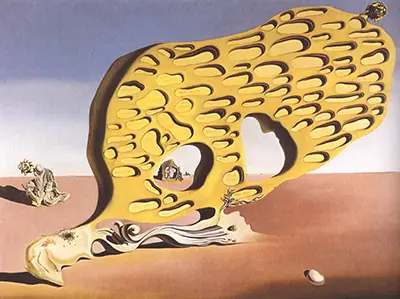Like most of Sali's paintings, locales from real life feature in The Enigma of Desire, particularly Cape Creus near Cadaqués, the birthplace of Dali's father and a place he loved "with fanatical loyalty". The mostly barren blue and brown background, typical of Sali's paintings, draws attention to the central large shape in the middle. The shape arises from a rock shaped like a sleeping human. Most probably, this was a self portrait of Dali himself. The large shape is shown to be protruding from the sleeping shape on the ground. Dreams being a constant subject of Dali (and surrealists in general), the large shape imbues itself with many dreamlike qualities.
Almost half of the eighty one compartments pressed into the central shape contain the words ma mère ("my mother". The other half, farthest from the head, seem to still be waiting for words to be etched into them. On the left, above Dali's sleeping head is one of his characteristic strange amalgam shapes. It possesses the head of a woman, a lion, a locust (ever present in many of Dali's drawings) and a young man. The young man's form also has arms encircling the egg-shaped head of another older man who, in turn, reaches around to stab the form in the back with a knife. On two sides of what would be the geometrical center of the frame, two large apertures can be seen in the dominant shape of the painting.
Through the left hole, a distant rock structure is set in stark color contrasts with the white and brown sky and land. The structure features the torso of a woman. On the extreme top-right, a smaller protrusion comes out of the larger shape, seemingly resembling the head of an animal. The base of the large structure is shaped like the curved forms of fin de siècle architecture and furniture, with intricate and elegant designs encrusted throughout. The base also has molluscs, which strengthens the allusions to Cape Creus. The painting is currently on display at the Gallery of Modern Art in Munich.

